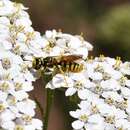Distribution
provided by Catalog of Hymenoptera in America North of Mexico
Rocky Mt. and Pacific Coast States, N. Dak., Alta., B. C.
- bibliographic citation
- Catalog of Hymenoptera in America North of Mexico. 1979. Prepared cooperatively by specialists on the various groups of Hymenoptera under the direction of Karl V. Krombein and Paul D. Hurd, Jr., Smithsonian Institution, and David R. Smith and B. D. Burks, Systematic Entomology Laboratory, Insect Identification and Beneficial Insect Introduction Institute. Science and Education Administration, United States Department of Agriculture.
General Ecology
provided by Catalog of Hymenoptera in America North of Mexico
Nests in rather diffuse aggregations in hard stony soil, usually makes only one nest during lifetime of an individual female containing up to 15 cells, stores 12-24 small prey per cell.
- bibliographic citation
- Catalog of Hymenoptera in America North of Mexico. 1979. Prepared cooperatively by specialists on the various groups of Hymenoptera under the direction of Karl V. Krombein and Paul D. Hurd, Jr., Smithsonian Institution, and David R. Smith and B. D. Burks, Systematic Entomology Laboratory, Insect Identification and Beneficial Insect Introduction Institute. Science and Education Administration, United States Department of Agriculture.
Philanthus crabroniformis: Brief Summary
provided by wikipedia EN
Philanthus crabroniformis is a species of bee-hunting wasp (or "beewolf") of North America. The species primarily preys upon Halictidae. They nest in sandy soils.
- license
- cc-by-sa-3.0
- copyright
- Wikipedia authors and editors

